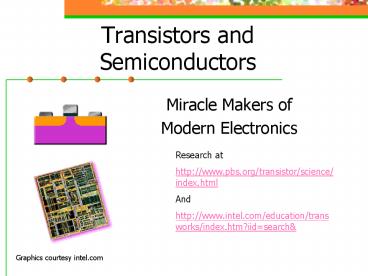Transistors and Semiconductors - PowerPoint PPT Presentation
1 / 23
Title:
Transistors and Semiconductors
Description:
Animation of Junction Transistor Microchips There was the vacuum tube Graphics courtesy How Stuff Works (Holes and electrons meet at junction, combine ... – PowerPoint PPT presentation
Number of Views:269
Avg rating:3.0/5.0
Title: Transistors and Semiconductors
1
Transistors and Semiconductors
- Miracle Makers of
- Modern Electronics
Research at http//www.pbs.org/transistor/science/
index.html And http//www.intel.com/education/tran
sworks/index.htm?iidsearch
Graphics courtesy intel.com
2
Related links
- http//www.pbs.org/transistor/science/info/transmo
dern.html - Direct link to field effect animation
- http//www.pbs.org/transistor/quicktimes/movieclip
s/fieldeffectVIDEO/fieldeffectVIDEO_56K.mov
3
State Standard
- Student know the properties of transistors and
the role of transistors in electric circuits.
4
Microchip vs Transistor vs. Semiconductor
- Semiconductor- element with both conducting and
insulating properties - Transistor an electronic device that uses
properties of semiconductors - Microchip contains many transistors
5
Before Transistors
There was the vacuum tube
6
Silicon
- Element with atomic number 14
- Four electrons in outer shell
- Makes perfect crystals
- No free electrons
- available for conduction
7
Doping Add Impurities
- Add phosphorus or arsenic with 5 outer electrons
provides free electrons needed for electric
current to flow - Makes N- type silicon
- Charges that flow are negative electrons
- Doped silicon is semiconductor
8
Diode Simplest Semiconductor Device
- Connected this way, no current flows
- When battery polarity reversed
- current can flow
- Diodes conduct only
- one way
(Holes and electrons meet at junction, combine
new ones form)
Graphics courtesy How Stuff Works
9
Transistors Tiny Switches
- Can be On or Off
Microprocessors work by binary flow of
information ones and zeros
10
Transistors consist of three terminals the
source, the gate, and the drain.
This type of transistor is called a Field Effect
Transistor
Text and graphics courtesy intel.com
11
In the n-type transistor, both the source and the
drain are negatively-charged and sit on a
positively-charged well of p-silicon.
12
When positive voltage is applied to the gate,
electrons in the p-silicon are attracted to the
area under the gate forming an electron channel
between the source and the drain.
13
When positive voltage is applied to the drain,
the electrons are pulled from the source to the
drain. In this state the transistor is on.
14
If the voltage at the gate is removed, electrons
aren't attracted to the area between the source
and drain. The pathway is broken and the
transistor is turned off.
15
P Type Transistors
- Add boron or gallium to silicon
- Have only three outer electrons
- Form holes that can accept an electron from a
neighbor - Also conducts current
- Majority current carriers are holes () rather
than electrons (-) - Less common today
16
Junction(Bi-polar) Transistors
- Terminals are emitter, base and collector
instead of source, gate and drain - Less common today
Bipolar transistors are essentially "current"
amplifiers while FETS could be considered voltage
amplifiers.
17
Amplification in Bi-Polar Transistor
- A small change in current in the emitter base
circuit produces a large change in current
through the collector. - link
18
(No Transcript)
19
Closer Look PNP Junction Transistor
- If a positive voltage is applied to the emitter,
current will flow through the p-n junction with
"holes" moving to the right and "electrons moving
to the left.
Taken from http//www.electronics-tutorials
.com/basics/transistors.htm
20
Field Effect Transistors
- weak electrical signal coming in through one
electrode creates an electrical field through the
rest of the transistor. This field flips from
positive to negative when the incoming signal
does, and controls a second current traveling
through the rest of the transistor. The field
modulates the second current to mimic the first
one -- but it can be substantially larger.
From PBS.org http//www.pbs.org/transistor/scien
ce/info/transmodern.html
21
Animation of Junction Transistor
Explanation at Bell Labs website
http//www.lucent.com/minds/transistor/tech.html
22
(No Transcript)
23
Microchips
Consist of thousands or millions of transistors
and other electrical elements working together































